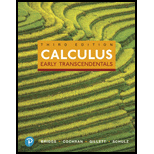
Motion with gravity Consider the following descriptions of the vertical motion of an object subject only to the acceleration due to gravity. Begin with the acceleration equation a(t) = v′ (t) = –g, where g = 9.8 m/s2.
a. Find the velocity of the object for all relevant times.
b. Find the position of the object for all relevant times.
c. Find the time when the object reaches its highest point. What is the height?
d. Find the time when the object strikes the ground.
109. A payload is released at an elevation of 400 m from a hot-air balloon that is rising at a rate of 10 m/s.
Want to see the full answer?
Check out a sample textbook solution
Chapter 4 Solutions
Calculus: Early Transcendentals (3rd Edition)
Additional Math Textbook Solutions
Calculus: Early Transcendentals (2nd Edition)
Elementary Statistics
College Algebra with Modeling & Visualization (5th Edition)
A First Course in Probability (10th Edition)
Basic Business Statistics, Student Value Edition
Algebra and Trigonometry (6th Edition)
- Question Determine lim f(x) given the definition of f(x) below. (If the limit does not exist, enter DNE.) x+6+ -2x²+3x-2 f(x) -2x-1 if x-5 if -−5≤ x ≤ 6 3 if x 6arrow_forwardQuestion Given the following piecewise function, evaluate lim f(x). (If the limit does not exist, enter DNE.) x-3 Provide your answer below: x² + 3x 3 if x-3 f(x) -3 if -3x -2x²+2x-1 6 if x 6arrow_forwardQuestion Given the following piecewise function, evaluate lim f(x). x→2 Select the correct answer below: -73 -24 -9 -12 The limit does not exist. 2x f(x) = -2x²-1 if -2x2 3x+2 if x 2arrow_forward
- Question Given the following piecewise function, evaluate lim f(x). f(x) = x+1- -2x² - 2x 3x-2 2 x² +3 if x-2 if -2< x <1 if x 1 Select the correct answer below: ○ -4 ○ 1 ○ 4 The limit does not exist.arrow_forwardQuestion Given the following piecewise function, evaluate lim →1− f(x). Select the correct answer below: ○ 1 ○ 4 -4 The limit does not exist. -2x² - 2x x 1arrow_forward(4) (8 points) (a) (2 points) Write down a normal vector n for the plane P given by the equation x+2y+z+4=0. (b) (4 points) Find two vectors v, w in the plane P that are not parallel. (c) (2 points) Using your answers to part (b), write down a parametrization r: R² — R3 of the plane P.arrow_forward
- (2) (8 points) Determine normal vectors for the planes given by the equations x-y+2z = 3 and 2x + z = 3. Then determine a parametrization of the intersection line of the two planes.arrow_forward(3) (6 points) (a) (4 points) Find all vectors u in the yz-plane that have magnitude [u also are at a 45° angle with the vector j = (0, 1,0). = 1 and (b) (2 points) Using the vector u from part (a) that is counterclockwise to j, find an equation of the plane through (0,0,0) that has u as its normal.arrow_forward(1) (4 points) Give a parametrization c: R R³ of the line through the points P = (1,0,-1) and Q = (-2, 0, 1).arrow_forward
- 4. Consider the initial value problem y' = 3x(y-1) 1/3, y(xo) = yo. (a) For what points (co, yo) does the IVP have a solution? (b) For what points (xo, yo) does the IVP have a unique solution on some open interval that contains 20? (c) Solve the IVP y' = 3x(y-1) 1/3, y(0) = 9 and determine the largest open interval on which this solution is unique.arrow_forwardFind the limit. (If the limit is infinite, enter 'oo' or '-o', as appropriate. If the limit does not otherwise exist, enter DNE.) lim X→ ∞ (✓ 81x2 - 81x + x 9x)arrow_forward2) Compute the following anti-derivative. √1x4 dxarrow_forward
- Algebra & Trigonometry with Analytic GeometryAlgebraISBN:9781133382119Author:SwokowskiPublisher:Cengage
 Holt Mcdougal Larson Pre-algebra: Student Edition...AlgebraISBN:9780547587776Author:HOLT MCDOUGALPublisher:HOLT MCDOUGAL
Holt Mcdougal Larson Pre-algebra: Student Edition...AlgebraISBN:9780547587776Author:HOLT MCDOUGALPublisher:HOLT MCDOUGAL Algebra: Structure And Method, Book 1AlgebraISBN:9780395977224Author:Richard G. Brown, Mary P. Dolciani, Robert H. Sorgenfrey, William L. ColePublisher:McDougal Littell
Algebra: Structure And Method, Book 1AlgebraISBN:9780395977224Author:Richard G. Brown, Mary P. Dolciani, Robert H. Sorgenfrey, William L. ColePublisher:McDougal Littell  Trigonometry (MindTap Course List)TrigonometryISBN:9781305652224Author:Charles P. McKeague, Mark D. TurnerPublisher:Cengage Learning
Trigonometry (MindTap Course List)TrigonometryISBN:9781305652224Author:Charles P. McKeague, Mark D. TurnerPublisher:Cengage Learning



